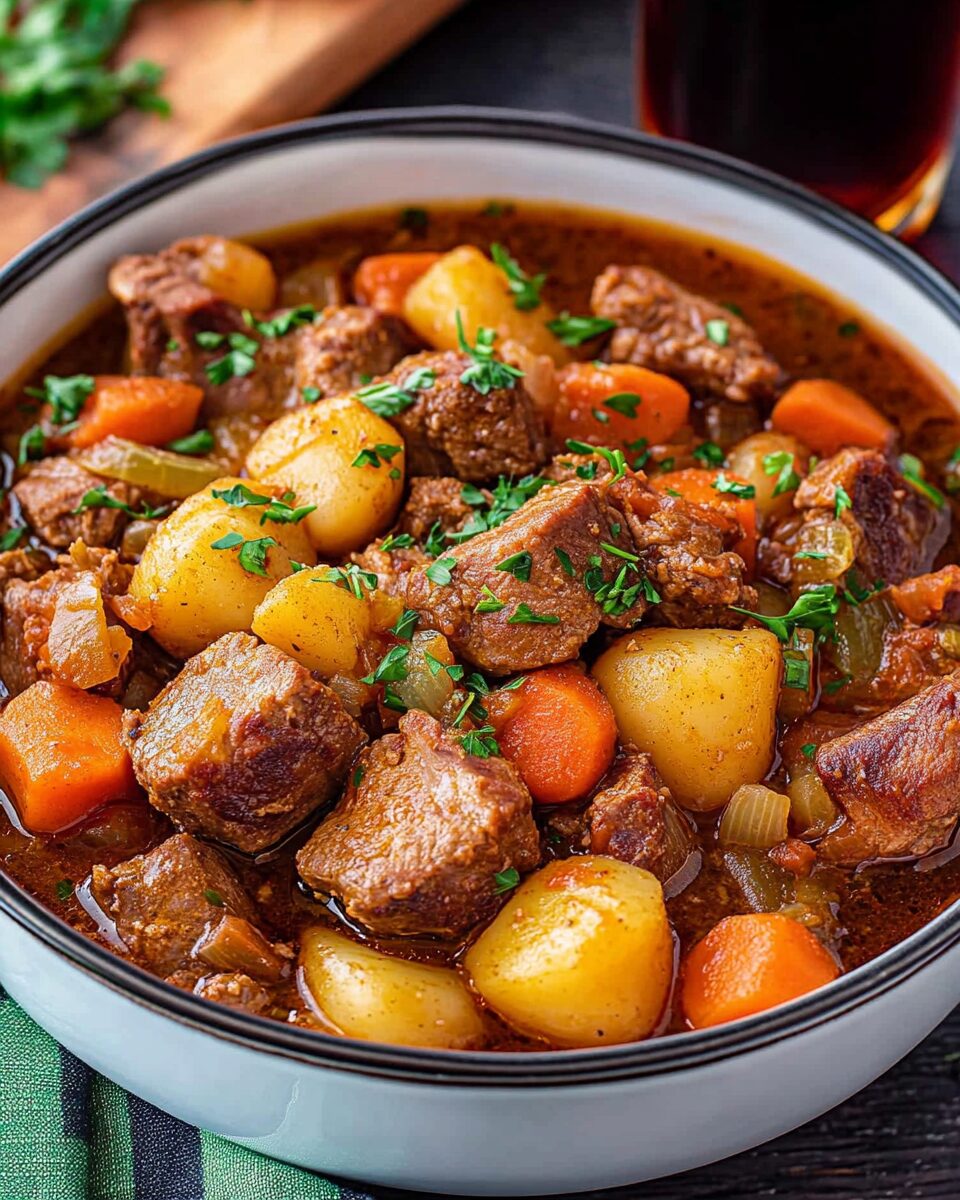Irish Lamb Stew with Guinness is a hearty and comforting dish perfect for chilly days. This traditional Irish recipe features tender lamb slow-cooked with root vegetables, aromatic herbs, and the rich, malty flavor of Guinness beer. The slow simmering process enhances the deep flavors, making it an ideal dish for gatherings or a cozy dinner at home.
Full Recipe:
Ingredients
- 2 lbs (900g) lamb shoulder, cut into chunks
- 2 tbsp olive oil
- 1 large onion, diced
- 2 cloves garlic, minced
- 3 carrots, peeled and chopped
- 2 celery stalks, chopped
- 3 large potatoes, peeled and cubed
- 1 parsnip, peeled and chopped (optional)
- 1 tbsp tomato paste
- 2 tbsp all-purpose flour
- 1 bottle (12 oz) Guinness stout
- 4 cups beef or lamb broth
- 2 tsp Worcestershire sauce
- 1 tsp dried thyme
- 1 tsp dried rosemary
- 2 bay leaves
- Salt and black pepper, to taste
- Chopped fresh parsley, for garnish
Directions
- Brown the Lamb: In a large pot or Dutch oven, heat the olive oil over medium-high heat. Add the lamb in batches and sear until browned on all sides. Remove and set aside.
- Sauté Vegetables: In the same pot, add the onion, garlic, carrots, and celery. Sauté for 3-4 minutes until softened.
- Thicken the Base: Stir in the tomato paste and flour, mixing well to coat the vegetables. Cook for 1-2 minutes to remove the raw flour taste.
- Add Liquids & Seasoning: Pour in the Guinness, scraping the bottom of the pot to deglaze. Add the broth, Worcestershire sauce, thyme, rosemary, and bay leaves. Stir well.
- Simmer the Stew: Return the browned lamb to the pot. Bring to a boil, then reduce the heat to low. Cover and let simmer for 1.5 to 2 hours, stirring occasionally.
- Add Potatoes & Final Simmer: Add the potatoes and parsnip (if using). Simmer uncovered for another 30 minutes, or until the vegetables are tender and the stew thickens.
- Season & Serve: Remove bay leaves, season with salt and black pepper to taste, and garnish with fresh parsley. Serve hot with crusty bread.
Nutrients (Per Serving, Approximate)
- Calories: 450 kcal
- Protein: 35g
- Carbohydrates: 40g
- Fat: 18g
- Fiber: 6g
- Iron: 4mg
- Vitamin A: 120% DV
- Vitamin C: 40% DV
Enjoy this classic Irish Lamb Stew with Guinness for a rich and satisfying meal!
The History of Irish Lamb Stew
Lamb stew has been a part of Irish cuisine for centuries, dating back to when sheep were one of the most common livestock in Ireland. Initially, the dish was a simple preparation using mutton, which was tougher but more affordable than lamb. Over time, the recipe evolved, incorporating local root vegetables such as potatoes, carrots, and onions. The introduction of Guinness stout to the stew was a later adaptation, enhancing the dish with a malty depth that perfectly complements the richness of the lamb. Today, Irish Lamb Stew with Guinness is a beloved dish, particularly popular during St. Patrick’s Day celebrations and family gatherings.
Why Guinness is the Perfect Addition
Guinness, Ireland’s most famous stout, brings a unique depth to the stew. Its dark, roasted malt flavor pairs wonderfully with the rich taste of lamb, adding a subtle bitterness that balances the sweetness of the carrots and onions. The carbonation in Guinness also helps tenderize the meat, ensuring that each bite is succulent and flavorful. The stout’s complexity infuses the broth with layers of taste, making the stew a truly memorable dish.
Cooking Method: Slow Simmering for Maximum Flavor
One of the key aspects of Irish Lamb Stew with Guinness is its slow-cooked nature. Cooking the lamb at a low temperature for an extended period allows the connective tissues to break down, resulting in fork-tender meat that melts in your mouth. This method also enables the flavors to develop and deepen over time. The gradual cooking process ensures that the broth thickens naturally, eliminating the need for heavy thickeners while maintaining a luscious consistency.
Variations of Irish Lamb Stew
While the classic recipe remains the most popular, variations of Irish Lamb Stew exist based on regional and personal preferences. Some variations include:
- Mutton Instead of Lamb: Traditional versions often used mutton, which has a stronger flavor and benefits from slow cooking.
- Different Beers: While Guinness is the most common choice, other stouts or ales can also be used for different flavor profiles.
- Additional Vegetables: Some recipes incorporate mushrooms, leeks, or turnips to enhance the texture and nutritional value.
- Herbs and Spices: While thyme and rosemary are traditional, some cooks add bay leaves, parsley, or even a hint of paprika for extra depth.
Pairing Suggestions
Irish Lamb Stew with Guinness is best enjoyed with sides and beverages that complement its rich flavors. Here are some excellent pairings:
- Crusty Bread: A warm loaf of Irish soda bread or sourdough is perfect for soaking up the flavorful broth.
- Mashed Potatoes: A side of buttery mashed potatoes enhances the stew’s hearty nature.
- Green Vegetables: Steamed cabbage or Brussels sprouts add a fresh contrast to the dish.
- Irish Stout or Red Ale: If you enjoy beer, pairing the stew with another Irish stout or a red ale enhances the overall experience.
- Full-Bodied Red Wine: A glass of Cabernet Sauvignon or Malbec pairs well with the richness of the lamb and stout-infused broth.
Health Benefits of Irish Lamb Stew
Despite its hearty nature, Irish Lamb Stew with Guinness offers several nutritional benefits:
- Rich in Protein: Lamb is an excellent source of protein, which is essential for muscle repair and growth.
- Packed with Vitamins and Minerals: The vegetables in the stew provide essential vitamins like vitamin A (from carrots) and vitamin C (from potatoes and parsley).
- Iron-Rich: Lamb is a great source of iron, which supports red blood cell production and energy levels.
- Low in Processed Ingredients: Unlike many modern stews that rely on processed broths or artificial thickeners, this stew primarily uses natural ingredients, making it a wholesome choice.
Tips for Making the Best Irish Lamb Stew
To ensure your stew turns out perfect every time, consider the following tips:
- Use Quality Lamb: Opt for lamb shoulder or shank, as these cuts become incredibly tender when slow-cooked.
- Sear the Meat First: Browning the lamb before simmering helps develop a deeper, more robust flavor.
- Deglaze the Pan: When adding Guinness, scrape the bottom of the pot to incorporate all the flavorful browned bits into the stew.
- Don’t Rush the Cooking Process: Allow the stew to simmer slowly for the best texture and taste.
- Season Gradually: Add salt and pepper at different stages to build balanced seasoning rather than overwhelming the dish at once.
Storing and Reheating the Stew
Irish Lamb Stew with Guinness stores exceptionally well and often tastes even better the next day as the flavors continue to meld. Here’s how to store and reheat it properly:
- Refrigeration: Store the stew in an airtight container in the fridge for up to 3 days.
- Freezing: Freeze portions in sealed containers for up to 3 months. Thaw overnight in the refrigerator before reheating.
- Reheating: Warm the stew on low heat on the stovetop, stirring occasionally to prevent sticking. Add a splash of broth or water if it has thickened too much.
Conclusion
Irish Lamb Stew with Guinness is more than just a meal—it’s a celebration of Ireland’s culinary heritage. Its rich, comforting flavors and wholesome ingredients make it an excellent choice for cozy family dinners, special occasions, or simply enjoying a taste of Irish tradition. The combination of tender lamb, hearty vegetables, and the deep, malty notes of Guinness creates a dish that is both nourishing and satisfying. Whether served with crusty bread, a pint of stout, or a side of mashed potatoes, this stew is sure to become a favorite. So, the next time you’re looking for a dish that embodies warmth and tradition, try making Irish Lamb Stew with Guinness—you won’t be disappointed!






